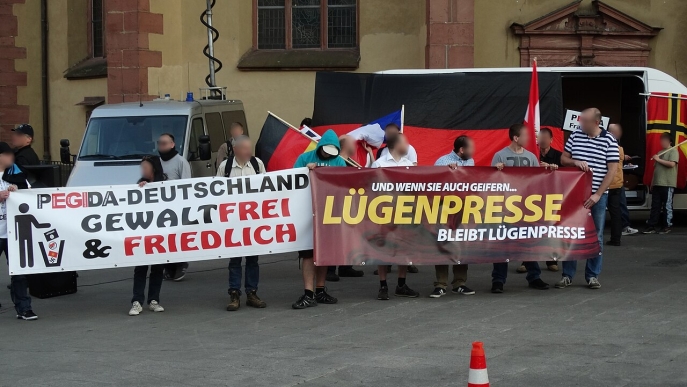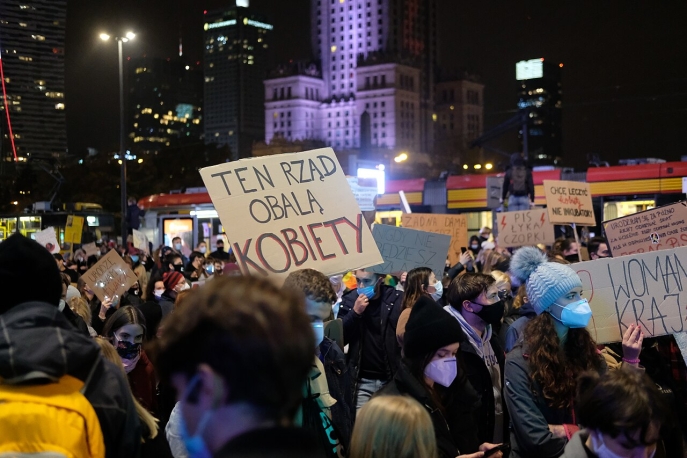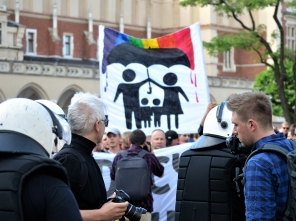(University of Florida - College of Liberal Arts & Science)
In thinking about grassroots conservative and radical right mobilisation in the current era, it is important to contextualise it in terms of regime type and who holds power. This piece is an attempt to sketch a theoretical framework of that sort based on the concept of mode of civil society developed elsewhere.1 The four modes are insurgent, institutionalised, authoritarian, and firewall.
The notion of mode is defined by the nature of rule and the identity of the ruler, so it is ideally adapted to this kind of contextualisation. In the sections that follow I illustrate the roles that conservative and radical right mobilisation have played in different modes as a way to characterise and systematise varieties of mobilisation by the political right across time and space.
Insurgent civil society
Insurgent civil society exists in opposition to authoritarian rule.
The end to authoritarian rule begins with a phase of liberalisation in which restrictions on speech and association are reduced. This is initiated by a split in the ruling elite provoked by a crisis of rule.2 If civil society protest was not the precipitant of the crisis, then the reduction in restrictions will also lead to an activisation of civil society. Thus, no matter the origins of the crisis, civil society mobilisation is intrinsic to crises of rule in authoritarian regimes.
Such processes involve a broad range of civic groups, including professional associations, unions, proto-parties, and interest groups. Such mobilisations are ideologically expansive and have encompassed most social groups, especially those focused in urban areas. It will include political forces on the right. Many of the democratisations of the Third Wave followed this pattern, which Mark Beissinger has labelled “urban civic social revolution.”3
Such challenges may lead to a variety of outcomes – a democratic transition, a reequilibration of autocracy, or a transition to a new form of authoritarianism. The path of democratisation necessitates the neutralisation of radical elements in civil society and their maximalist demands, as this path requires some form of understanding or compromise with reformist elements among the authoritarian incumbents. In most cases this leads to the marginalisation of far-right political actors who often have maximalist demands, particularly in postcommunist scenarios. More mainstream conservatives often come to play an important role in the transition and the post-transition political environment.
In some exceptional cases, more radical forces may find themselves in the driver’s seat after transition. For instance, in the Arab Spring fundamentalist Islamic groups were central to democratisation. Both the Islamic Brotherhood in Egypt and Ennahda in Tunisia were indispensable to the overthrow of dictatorship in both countries. However, there is a strong case to be made that Ennahda strongly moderated after transition, and that this helps to explain why the democratic interlude in Tunisia was much longer than in Egypt.4
Reequilibration of authoritarianism can occur after liberalisation if civil society is not successful in pushing the regime into deeper democratic reform. In cases where the government is conservative, conservative or radical-right civil society organisations can provide support for a reformed form of dictatorship. Such organisations may be willing to settle for liberalisation and not push for further reform, isolating those pushing for greater change and closing off democratisation in a reformed version of the existing dictatorship.
Sometimes the liberalisation of an authoritarian regime can lead to the creation of an alternative authoritarian regime. The most common form of neo-authoritarianism we see in the current age is patrimonial in nature.5 Nationalism often works as an effective ideological cover for patrimonialism. Nationalist movements on the right fit easily into patrimonial networks. This was the modal outcome in the successor states to the Soviet Union, where nomenklatura elites cloaked themselves in the rhetoric of nationalism and democracy.6 Despite the rhetoric, the resulting regimes never democratised and former elites reconsolidated and privatised their hold on power. Russia, for instance, provides a number of excellent examples of far-right groups that helped to consolidate authoritarian rule, e.g. the Kadyrov faction that runs Chechnya for Putin, Yevgeny Prigozhin’s creation of the Wagner group (a private group of mercenaries that served Russian foreign policy and military interests), or the philosopher Aleksandr Dugin and other peddlers of neo-Eurasianism.
Institutionalised civil society
Institutionalised civil society exists as part of both democratic and even some milder authoritarian regimes as a central component of the system of interest articulation and representation. It acts to secure the collective interests of their sponsors and/or members. It includes trade unions, interest associations, social movements, non-governmental organisations (NGOs), employers’ associations, foundations, professional groups, and the like. It works in two ways. First, through institutionalised channels of interest articulation such as lobbying, advocacy, and agenda setting it seeks to affect the decision-making of political parties, executive agencies, and legislatures. Second, they engage in limited and often institutionalised contentious activity to bring attention to their causes, to affect the political agenda, or to block developments deemed harmful to their interests.7
Under stable institutionalised democracy far-right movements are allowed to exist, agitate, recruit, mobilise and protest. The history of the United States is replete with examples of this – the Klan, the John Birch society, and the interwar pro-Nazi German American Bund. Under normal conditions such organisations remain marginal to party competition. However, in the history of the United States, the Klan was significant in enforcing one party rule and preventing African American suffrage resulting in subnational authoritarianism in a nominally democratic system for a period of decades.8 Similar movements with an anti-Islamic agenda have arisen in Europe such as PEGIDA (Patriotische Europäer gegen die Islamisierung des Abendlandes [Patriotic Europeans Against the Islamisation of the West]) in Germany or the British National Party in the UK.

Participants in a Pegida demonstration in Frankfurt, April 21, 2015. Banner 1 reads: “Pegida-Germany. Violence-free and Peaceful”. Banner 2 reads: “And even if you drool… the lying press remains the lying press”.
Authoritarian civil society
There are two variants of authoritarian civil society depending on who rules. They can be power-seeking or power-supporting.
First, it can refer to CSOs (civil society organizations) under democratic rule that support political parties that seek to weaken or overthrow democracy. This can also refer to social movements or movement parties at the political extremes. The classic example of this is the fascist March on Rome that put Mussolini in power in 1922. Similar attempts to take power were organised in Weimar Germany during the Kapp and Beerhall putsches. The communist takeover of Czechoslovakia in 1948 had elements of this as well.
In the contemporary period populist parties have worked to develop sympathetic organisations in civil society that help them to mobilise against their opponents in power, take power electorally, and to support their agenda of undermining democratic accountability when in power. Some of the best empirical work here has been done on the contemporary cases of democratic backsliding in Hungary and Poland.
In Hungary, a series of discussion clubs were built nationally, the so-called Civic Circles, which propagated Fidesz’s message across the country. Simultaneously, a movement further to the right, Jobbik also began to grow. When Prime Minister Ferenc Gyurcsány was caught admitting that he lied about the economy in his re-election campaign in 2006, both Fidesz and Jobbik mobilised and took to the streets with an extensive campaign of protest which led to pitched battles between the police and protestors in front of the parliament building. The crisis hobbled the government, led to its early fall and its replacement by the government of Gordon Bajnai, an independent who ruled with the minority support of the socialists. This opened the way for Fidesz to triumph decisively in the elections of 2010.9Since then, it has ruled Hungary and has replaced democracy with competitive authoritarian rule.
Anti-government protest at Kossuth Square, Budapest, Hungary, October 10, 2006. The demonstration was organized by Fidesz-KDNP, with an address by Zsolt Semjén (KDNP parliamentary group leader).
In Poland, there was a similar initiative created by the Clubs of the Polish Gazette (a rightist newsweekly). There were other movements associated with the traditional Catholicism practiced by Father Tadeusz Rydzyk, and his media empire (including a radio, a television channel, and a newspaper). Additionally, far right circles in the country politicised the celebration of Polish independence (November 11, 1918) to push their agenda.10 Finally, PiS was skilful in supporting socially conservative and religious initiatives about children and schooling. During the elections of 2015 for the Presidency and legislature, PiS was able to mobilise these populations against the Platforma Obywatelska (Civic Platform) government’s limited cooperation with the EU on refugee settlement.[11 This surge in popularity allowed PiS to stay in power for two consecutive terms, and its policies induced a period of democratic backsliding, though not breakdown.
Firewall civil society
Firewall civil society exists in situations where democracy is under threat. Democracy is protected by three forms of accountability – the vertical accountability provided by elections, the horizontal accountability provided by the separation of powers, and the social accountability provided by civil society contention. The ability of democrats to defend democracy is enhanced by a combination of all three, but as horizontal and vertical are undermined by autocratic policies, social accountability serves as a means to defend horizontal and vertical and can function as a last-ditch line to defend democracy until the next set of elections. Civil society organisations defend democracy by monitoring the actions of state bureaucracy to bring attention to abuses of power, contesting autocratic actions by the executive in the courts, and protesting. While it is difficult to remove elected leaders, even autocratic ones, by protest, it does create reputational costs that undermine an incumbent’s popularity, hurting their chances at re-election.12
In the contemporary era, most firewall actions by civil society organisations have been to defend democratic accountability mechanisms in the face of populist onslaughts on liberal democracy. Most of these organisations have been centrist, socially liberal or left. However, on the party side of resistance, it is common to find some conservatives also standing for democracy in the face of right populist challenges. The Visegrád Group (V4) has been a hotbed for this sort of action.
Citizens Platform’s campaign that unseated PiS in Poland was possible because of the actions of the Committee to Defend Democracy’s (KOD) demonstrations to defend the Constitution and rule of law, the Women’s Strike’s massive mobilisations in defence of reproductive rights, and the actions of Judges and Lawyers to defend judicial independence. Their actions directly changed mobilisation patterns in the electorate, denying PiS a coalition majority despite its plurality victory.13

Warsaw Women’s Strike march, Warsaw, October 30, 2020. The main sign reads: “This government topples women.”
In Slovakia massive demonstrations in response to the murder of investigative journalist Jan Kuciak and his fiancé, Martina Kušnírová, in 2018 were responsible for bringing down the SMER government of Robert Fico.14 In Czechia the Million Moments for Democracy staged several large demonstrations before the parties could get their act together to defeat ANO and Andrej Babiš in 2021.15 The one country where sustained protest actions have not been effective in dislodging a right incumbent has been Hungary. Here the Orbán regime has a near monopoly on the large mass media outlets and constitutional majority in the parliament. This allows them to manipulate elections and to change law at will to undermine opposition. Hungary illustrates the limitations of the exercise of social accountability in isolation when horizontal and vertical have been undermined by the incumbent.16 It sadly demonstrates how civic courage, organisation, and a commitment to democracy on the part of civil society activists and organisation is not sufficient on its own to repel dictatorship.
There are examples of conservative organisations playing a prominent role in the defence of democracy in parts of the world where left incumbents have undermined democratic accountability and used patrimonialism to enrich themselves and their followers. In Latin America, the resistance to Chavez and Maduro in Venezuela, and Ortega in Nicaragua has been ideologically broad and has included business interests and conservative political parties. Conservative democrats are a vital part of firewall civil society where left incumbents are the ones working to undermine democratic accountability.
Final thoughts. A fifth mode?
We are in a time of party-system realignment away from the postwar stability of centre-left, centre-right competition and alternation in most established democracies. Systems are polarising and split between parties that defend the liberal democratic status quo and those which subscribe to right-wing populist ideas. This is because liberal democracy has stumbled in the face of a profound crisis of representation. Many voters have long felt that the established parties no longer listen to them or effectively advocate and serve their interests.
The parties are divided on many key issues. Highly salient divisions exist on the issues of immigration, women’s rights, and gender. Science and expertise have also emerged as an area of contention, with polarisation on issues of medicine and public health, as well as global warming and how to respond to it. The economic dimension is less clear. Liberals are split between parties that seek to re-embed capitalism with those who still subscribe to the basic tenets of the neoliberal order. Populists play off feelings of economic insecurity, but in practice some stand for more “native welfare,” while others support market utopianism.
However, it is not policy differences that most profoundly separate the parties. It is the regime question. The liberals defend democracy at the level of procedure – rule of law, accountability, bureaucratic neutrality and judicial independence – and the informal norms that accompany them. The populists claim to be advocating for a more substantive democracy that responds to popular dissatisfaction. They are prepared to steamroll the formal rules and informal norms to win and put their agenda into place, while the liberals try to protect the guardrails and precedents that sustain democracy.
This party polarisation has had critical ramifications for civil society. Both party families have developed their own supporting civil society organisations. These are mobilised in favour of party programs, play a role in mobilising voters, and engage in contentious protest when their opponents hold power. Civil society has thus become a vertically segmented and politicised realm of constant contestation where authoritarian and firewall civil society are locked in competition with each other.17

Confrontation at the entrance of Emancipation Park during the “Unite the Right” rally in Charlottesville, August 12, 2017.
The ramifications for democracy of this configuration are well-known and dangerous. We saw similar patterns of party polarisation consuming civil society in both interwar Europe and Cold War Latin America. The logic here was somewhat different. In interwar Europe reactionary parties mobilised traditional groups in civil society against democracy and were met by counter-mobilisation from large, organised parties on the left. The ruling centrist parties disintegrated in this scenario opening the way to widespread dictatorship in Southern, Central, and Eastern Europe. Western European states were more durable because they had greater resources to deal with challenges to democracy. In Latin America a left emboldened by the success of the Cuban Revolution underestimated the costs of taking power. This brought a conservative overreaction by praetorian militaries that overthrew electoral democracy based on a miscalculation of the tangibility of a revolutionary leftist seizure of power.18
Luckily, our situation is not yet so dire. Populists chip away at democracy rather than make coups d’état or putsches. However, the durability of democracy is not just a question of a strong firewall civil society that helps to defend horizontal and vertical accountability or helps mobilise voters to defeat populism electorally. Until such point, that political parties address the crisis of representation that makes the promises of populist politicians attractive, populism will remain embedded in the party system. And when populists win, they will act in ways that undermine the accountability mechanisms that make democracy self-enforcing and stable.
Notes
1
Michael Bernhard, “What Do We Know about Civil Society and Regime Change Thirty Years after 1989?,” East European Politics, vol. 36, no. 3, 2020, pp. 341-362. doi:10.1080/21599165.2020.1787160.
2
Guillermo O'Donnell and Philippe C. Schmitter, “Tentative Conclusions about Uncertain Democracies.,” in Guillermo O'Donnell, Philippe C. Schmitter, and Laurence Whitehead (eds.), Transitions from Authoritarian Rule, Baltimore, The Johns Hopkins University Press, 1986, Part IV, pp. 1-72; and Adam Przeworski, Democracy and the Market, Cambridge, Cambridge University Press, 1991.
3
Mark R. Beissinger, The Revolutionary City: Urbanization and the Global Transformation of Rebellion, Princeton, Princeton University Press, 2022.
4
Elizabeth R. Nugent, After Repression: How Polarization Derails Democratic Transition, Princeton, Princeton University Press, 2020.
5
Stephen E. Hanson and Jeffrey S. Kopstein, The Assault on the State: How the Global Attack on Modern Government Endangers Our Future, Hoboken, Polity Press, 2024.
6
Henry E. Hale, Patronal Politics: Eurasian Regime Dynamics in Comparative Perspective, New York, Cambridge University Press, 2015; and Lucan A. Way, “Authoritarian State Building and the Sources of Regime Competitiveness in the Fourth Wave: The Cases of Belarus, Moldova, Russia, and Ukraine,” World Politics, vol. 57, no. 2, 2005, pp. 231-261. https://dx.doi.org/10.1353/wp.2005.0018.
7
Sidney Tarrow, “Cycles of Collective Action: Between Moments of Madness and the Repertoire of Contention,” Social Science History, vol. 17, no. 2, 1993, pp. 281-307. https://doi.org/10.2307/1171283.
8
Robert Mickey, Paths Out of Dixie: The Democratization of Authoritarian Enclaves in America's Deep South, 1944-1972, Princeton, Princeton University Press, 2015.
9
Bela Greskovits, “Rebuilding the Hungarian Right Through Conquering Civil Society: The Civic Circles Movement,” East European Politics, vol. 36, no. 2, 2020, pp. 247-266; Laura Jakli, Bela Greskovits, and Jason Wittenberg, “Asymmetric Mass Mobilization and the Vincibility of Democracy in Hungary,” Comparative Political Studies, 2025. https://doi.org/10.1177/00104140241312093; Dae Soon Kim, “The Rise of European Right Radicalism: The Case of Jobbik,” Communist and Post-Communist Studies, vol. 49, no. 4, 2016, pp. 345-357. https://doi.org/10.1016/j.postcomstud.2016.08.001; Anna Seleny, “Revolutionary Road: 1956 and the Fracturing of Hungarian Historical Memory,” in Michael Bernhard and Jan Kubik (eds.), Twenty Years After Communism: The Politics of Memory and Commemoration, New York, Oxford University Press, 2014, pp. 37-59.
10
See on this subject Frédéric Zalewski, “Les Marches de l’Indépendance à Varsovie. Recompositions et transformations des droites extrêmes depuis les années 2000 en Pologne”, Cultures & Conflits, no. 117, 2020, pp. 35-59.
11
Stanley Bill, “Counter-Elite Populism and Civil Society in Poland: PiS’s Strategies of Elite Replacement,” East European Politics and Societies, vol. 36, no. 1, 2022, pp. 118-140. https://doi.org/10.1177/0888325420950800; Agnieszka Graff and Ela Korolczuk, Anti-Gender Politics in the Populist Moment, London, Routledge, 2021; Marta Kotwas and Jan Kubik, “Symbolic Thickening of Public Culture and the Rise of Right-Wing Populism in Poland,” East European Politics and Societies, vol. 33, no. 2, 2019, pp. 435-471. https://doi.org/10.1177/0888325419826691; Daniel Płatek and Piotr Płucienniczak, “Civil Society and Extreme-right Collective Action in Poland 1990-2013,” Revue d’études Comparatives Est-Ouest, vol. 47, no. 4, 2016, pp. 117-146; Daniel Płatek and Piotr Płucienniczak, “Mobilizing on the Extreme Right in Poland: Marginalization, Institutionalization, and Radicalization,” in Kristan. Jacobsson and Ela Korolczuk (eds.), Civil Society Revisited: Lessons from Poland, New York, Berghahn Books, 2017, pp. 286-313; Yasuko Shibata, Discrimination for the Sake of the Nation: The Discourse of the League of Polish Families against “Others” 2001-2007, Frankfurt am Rhein, Peter Lang, 2013; Marcin Ślarzyński, “Rola klubów Gazety Polskiej w sukcesie politycznym Prawa i Sprawiedliwości w 2015 roku. Aktorzy lokalni czy actor ogólnokrajowej sfery publicznej III RP?,” Przegląd Socjolgiczny, vol. 67, no. 2, 2018, pp. 139-158; Piotr Kocyba, “Poland—Changing Patterns of Protest Mobilisation in a Polarised Society,” in Claudiu Crăciun and Henry P. Rammelt (eds.), Power and Protest in Central and Eastern Europe, Cham, Palgrave Macmillan, 2025, pp. 217-246. https://doi.org/10.1007/978-3-031-77888-9_9.
12
Lindsay Mayka, “Civil Society Mobilization against Equal Citizenship in Latin America,” in Valerie J. Bunce, Thomas B. Pepinsky, Rachel Beatty Riedl, and Kenneth M. Roberts (eds.), Global Challenges to Democracy: Comparative Perspectives on Backsliding, Autocracy, and Resilience, Cambridge, Cambridge University Press, 2025, pp. 143-158; and Mark R. Beissinger, “Civil Society Resistance to Democratic Backsliding,” in Valerie J. Bunce, Thomas B. Pepinsky, Rachel Beatty Riedl, and Kenneth M. Roberts (eds.), Global Challenges to Democracy: Comparative Perspectives on Backsliding, Autocracy, and Resilience, Cambridge, Cambridge University Press, 2025, pp. 196-214.
13
Michael Bernhard, “Post-Communist Democracy, Civil Society, and the Problem of Accountability,” in Valerie J. Bunce, Thomas B. Pepinsky, Rachel Beatty Riedl, and Kenneth M. Roberts (eds.), Global Challenges to Democracy: Comparative Perspectives on Backsliding, Autocracy, and Resilience, Cambridge, Cambridge University Press, 2025, pp. 176-195.
14
Miroslava German Sirotnikova, “Jan Kuciak: A Murder that Changed Slovakia,” balkaninsight.com, August 5, 2020. https://balkaninsight.com/2020/08/05/jan-kuciak-a-murder-that-changed-slovakia/
15
Kateřina Vráblíková, “Czech Republic—From Apathy to Mass Mobilisations, 1989-2022,” in Claudiu Crăciun and Henry P. Rammelt (eds.), Power and Protest in Central and Eastern Europe, Cham, Palgrave Macmillan, 2025, pp. 109-136.
16
Márton Gerő and Szabina Kerényi, “Hungary—The Changing Roles of Civil Society and Social Movements Facing Autocratization,” in Claudiu Crăciun and Henry P. Rammelt (eds.), Power and Protest in Central and Eastern Europe, Cham, Palgrave Macmillan, 2025, pp. 161-190.
17
Some observers have labelled these competing civil society fragments as pillarised and others as compartmentalised. Grzegorz Ekiert, “Civil Society as a Threat to Democracy,” in Nathan Stoltzfus and Christopher Osmar (eds.), The Power of Populism and People: Resistance and Protest in the Modern World, London, Bloomsbury Academic, 2022, pp. 53-72; Daniel Płatek, “Towards Pillarisation? Coalitions of Polish Protest in 2020,” East European Politics, vol. 40, no. 1, 2024, pp. 129-153. https://doi.org/10.1080/21599165.2023.2199984; Marcin Ślarzyński, “Transformation of Civil Society in Poland under the United Right Government: From Compartmentalization to Political Division,” Communist and Post-Communist Studies, vol. 55, no. 1, 2022, pp. 131-154. https://doi.org/10.1525/j.postcomstud.2022.55.1.131; and Paulina Pospieszna, Daniel Płatek, Grzegorz Piotrowski, and Aleksandra Monkos, “Pillarized Networks in a Polarized Civil Society: A Structure of Far-Right Networks in Poland,” Nationalities Papers, vol. 52, no. 6, 2024, pp. 1292-1307. https://doi.org/10.1017/nps.2023.47.
18
Sheri Berman, “Civil Society and the Collapse of the Weimar Republic,” World Politics, vol. 49, no. 3, 1997, pp. 401-429. https://doi.org/10.1353/wp.1997.0008; Nancy G. Bermeo, Ordinary People in Extraordinary Times: The Citizenry and the Breakdown of Democracy, Princeton, Princeton University Press, 2003. https://muse.jhu.edu/book/75884; Giovanni Capoccia, Defending Democracy: Reactions to Extremism in Interwar Europe, Baltimore, Johns Hopkins University Press, 2007; and Kurt Weyland, Revolution and Reaction: The Diffusion of Authoritarianism in Latin America, Cambridge, Cambridge University Press, 2019.










